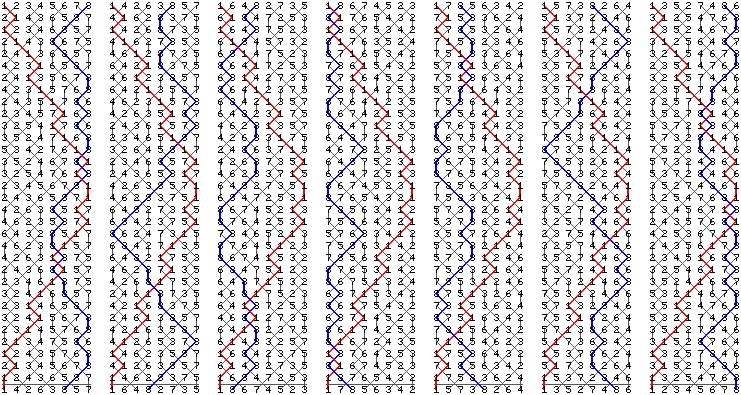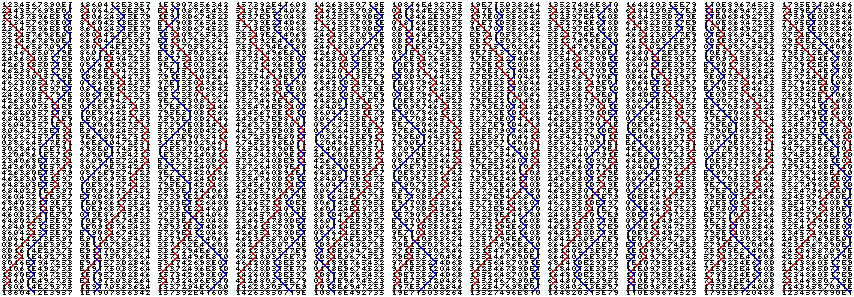
Bell ringing methods
Right then; if you've got this far, you must be fairly interested in this rather geeky subject. I'm impressed with you!
Like I said earlier, in a bell-ringing method the bells can only move one place at a time (or they can actually stay in the same place.)
The first example below is the simplest method possible. Any further methods are explained as simply as possible.

Plain hunt
This is the simplest thing in change ringing. All the odd bells start by moving one back in the sequence. All the even bells move forward in the sequence. When they get to the front or back respectively, they stay there for one "change", then alter direction.
Note that the "treble" bell (1) is highlighted in red. this will be important in all the further examples. The treble has an important role to play in most methods. There are a few exclusions to this, but way beyond the scope of these demonstrations!
The bell-path of a bell actually "ringing the method" is denoted by having its path in blue (normally the tenor bell, [biggest being rung.]) In plain hunt however, the blue-line is not important; all the bells do the same thing.
Plain Bob Major

The method above is one step up from plain hunt. It starts off exactly the same, but something happens when the treble (red bell) has its second turn at the front (in the lead.)
The bell directly behind it stays behind it for a second time (makes seconds,) then changes direction. All the bells behind these change direction a couple of times (dodge.)
This way, seven times more changes (than with plain hunt) can be made!
Bristol Surprise Major

Hmm... You've stayed with me until now. This is a fairly complex method; Bristol Surprise Major. All I'll say about it for now is that it has four points of symmetry (both directly, and inversely reflective!)
See if you can find them.
The treble (1) bell has a bit more work to do here, as it dodges in every place. This can still be a bit boring if you're actually ringing the treble for a peal. I've been "caught napping" before now while doing that!!!
You are possibly asking yourself by now, "How do you actually get to ring the 5040 changes mentioned in the previous page?"
You remember I said that there is a person responsible for conducting the ringing? Well, their duty is to make various "calls" during the method to slightly re-arrange the order of the bells. At the appropriate moment, they call (normally shout) "Bob", or "Single"! A Bob call affects an odd number of bells (even if it's only 3.) A single affects an even number of bells. This way, a method can be re-arranged around the time of the "call", so the bells come out of it in a somewhat different order.
When they find themselves in the new position, they carry on from that place until the next "call".
Stedman Triples

A bell which has an easy ride in most methods is the treble (1). In a few methods however, the treble is "in on the plot." One that comes to mind is Stedman. Here, the treble does exactly the same work as the other bells.
Note that this method is rung on an odd number of bells. The tenor (8) in a method like this just marks time by staying in 8th place throughout. Every change has 8 after it here, but it's not worth including in the change!
Let's explain the Major and Triples thing mentioned above!
In ringing, anything from 5 bells (realistically) to 12 bells can be rung. I'll explain the terms here.
Number of bells Named Maximum changes
3 Singles 6
4 Minimus 24
5 Doubles 120
6 Minor 720
7 Triples 5,040
8 Major 40,320
9 Caters 362,880
10 Royal 3,628,800
11 Cinques 39,916,800
12 Maximus 479,001,600
Note that the 9 and 11 bell methods are a translation from the French language. In true British style, one of them has been totally mis-spelled!
Caters comes from the French word 4 (quatre). Cinques comes from the French word 5 (cinq). Hmm.... Well; we got one of then right here, didn't we?!
London Pride Maximus
Before we put this whole thing to bed, let's have a 12 bell method. Just view it (you may need a magnifying glass!) If you've had enough click here to get out, and hopefully go to something more interesting to you, else scroll down for this one! 0 means 10, E means 11, T means 12!





If you still want to know more, go here for an "ebook" on the elements of ringing. I've noticed that a lot of my site visitors arrive at the site searching for information on bell-ringing. I've scanned in a book, originally published by the Central Council of Church Bell Ringers, published in 1973. I hope the text is legible enough.